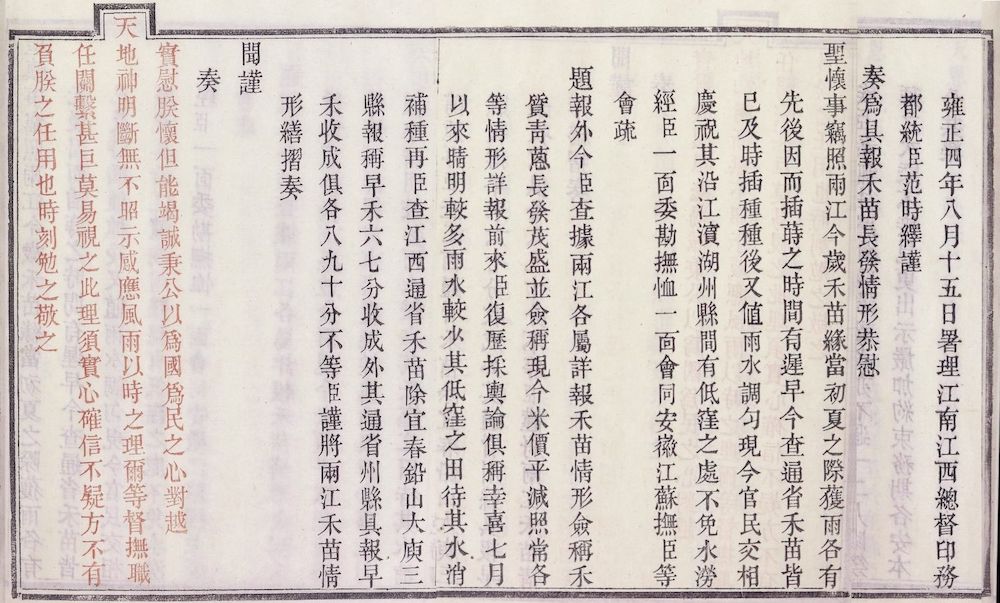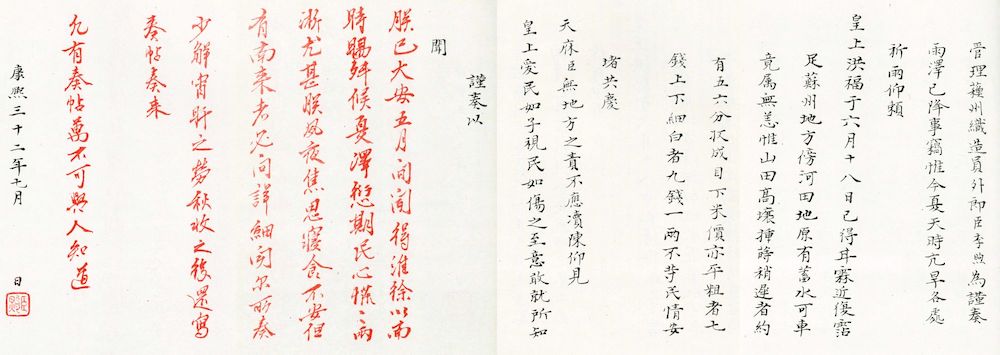Imperial edicts with vermillion (i.e., the emperor's) notes (zhupi yuzhi 硃批諭旨, or zhuyu 硃諭 for short) and "confidential memorials with vermillion notes" (zhupi zouzhe 硃批奏折, also called yupi zouzhe 御批奏折) were documents in which the emperor marked or annotated the text with red or vermillion ink. Marks were typically small circles written beside words or passages that could be marked. Annotations might also include questions on the matter, which had to be answered by the officialdom before further processing of the document.
There are several collections of "vermillion edicts", for instance Yongzheng zhupi yuzhi 雍正硃批諭旨, compiled under the supervision of Ortai (Ch. E'ertai 鄂爾泰, 1677-1745) and Zhang Tingyu 張廷玉 (1672-1755), and published in 1732 and revised in 1738. It consists of more than 8,000 memorials to the throne annotated by the emperor. The collection includes a preface written by the Yongzheng Emperor 雍正帝 (r. 1722-1735) of the Qing dynasty 清 (1644-1911), the revised version also includes an afterword by the Qianlong Emperor 乾隆帝 (r. 1735-1796). While the original documents were written by hand, the test of the edited Zhupi yuzhi was printed with letters in kaiti style 楷體. The Emperor himself decided on the most significant part of the documents. Sentences not publishable were crossed through. In case academicians literati (cichen 詞臣, usually academicians of the Grand Secretariat) suggested to alter the original text of a memorial, white slips were attached to the document on which the proposed text was written. If the emperor's notes were to be altered, the proposal was written on a yellow slip. On yet another type of paper, the document was copied with the modified text. Yet because this method was too complex, the editors began to copy original documents first before remarks were added concerning the alteration of the original text. The collection is arranged by person. For most texts, the originals are still preserved in the First Historical Archives (Zhongguo Di Yi Lishi Dang'anguan 中國第一歷史檔案館).
 |
Book print edition of an annotated memorial by Banner commander-in-chief (dutong 都統) Fan Shiyi 范時繹, acting as seal-holding governor-general of Jiangnan and Jiangxi. From the Siku quanshu 四庫全書 edition of the Yongzheng zhupi yuzhi 雍正硃批諭旨 (Shizong Xian Huangdi zhupi yuzhi 世宗憲皇帝朱批諭旨). From Guji zihua fenxiang 古籍字畫分享. |
Another collection of red vermillion remarks is Kangi chao Hanwen zhupi zouzhe huibian 康熙朝漢文硃批奏折匯編, published by the First Historical Archives in 1984-1985. It is arranged chronologically and includes more than 3,000 documents of memorials to the throne the originals of which are partially owned by the Archives in Beijing. About two thirds are reproductions of the collection Gongzhongdang Kangxi chao zouzhe 宮中檔康熙朝奏折 that consists of documents owned by the Palace Museum (Gugong Bowuyuan 故宮博物院) in Taibei.
 |
Memorial of Li Xu 李煦, supervisor of the silk manufactory (zhizaofang 織造房) of Suzhou 蘓(=蘇)州. From Chen & Li 1995. |